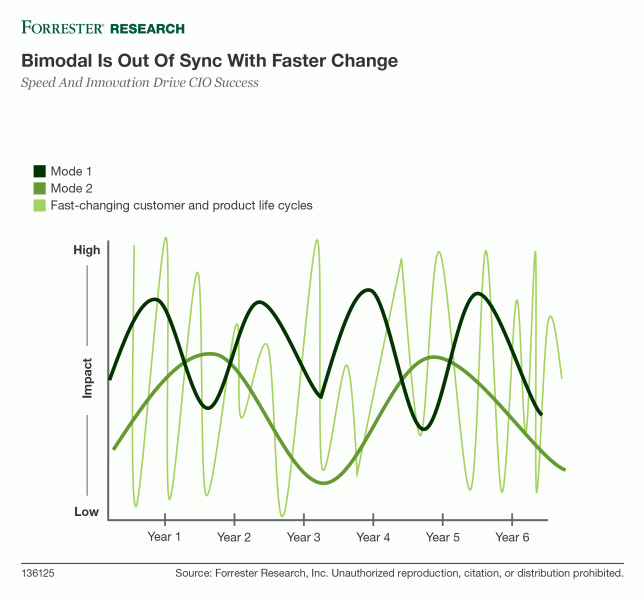Bimodal IT Is Past Its Due Date: Providing Speed And Innovation Need To Top The CIO’s Agenda
Many CIOs have embraced bimodal IT as a way to create relevance for the technology organization in the age of the customer. With marketing, CX, and other teams increasingly building their own development teams or turning to outside agencies for their technology needs, CIOs have recognized that they need to help drive fast change, not be a source of friction. They also need to be a source of innovation for the business. Many CIOs took a shortcut to this end and created a “fast” IT function that sat parallel to the “slow” IT function — and hence bimodal IT was born.

However, most CIOs now recognize that all of the technology team and function needs to be fast. Yes, some systems change less often than others, but all change needs to be fast. There is no longer an appetite for long, drawn-out, technology-led changes. There is no longer a place for slow IT. Testing can’t delay launches; security can’t add months to a project; perfect can’t get in the way of fast. CIOs are taking steps to create a tech function that moves at the speed of the customer and helps drive innovation for customers, partners, and employees. They are starting to create a true business technology function. Here’s what leading CIOs are doing to drive this change and move away from bimodal IT:
- They are creating a vision of the new empowered customer future and selling this to their team, the board, and the rest of the business to get buy-in for the changes they are making across their team.
- They are transforming the culture, skills, technology, and metrics of the technology team. Start with the vision and inspire the team to change, or start with the metrics and drag them along with you — either way, these changes are essential.
- In order to transform the skills in the tech team, they are developing a skills matrix for what is required today and tomorrow and mapping technology assets to the current and future states.
- They are embracing modern technology platforms and processes. Using public cloud is now commonplace, but leaders are surfing the wake of the large cloud platform providers, using cloud innovations to drive better customer and business outcomes. Microservices and APIs are helping older systems to be fast and secure; DevOps and Agile are starting to dominate the development and ongoing tech improvement approach of leading businesses; and companies that outsource some of their IT are shifting away from traditional sourcing arrangements to more flexible partnerships.